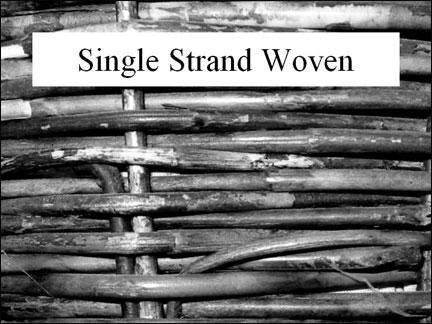
Basketry techniques include virtually every possible way there is to attach one piece of material to another without using glue or pins, although glue may be used to coat a basket to make it waterproof, or small seed proof. In looking at the common styles of basketry around the word, I like to break them first into three super-categories, and then further divide these (note: this is my own analysis for beginners, not a standardized ideal used by basket makers). I am using a technique common to botany keys going from major differences, down to the smaller.
I. Intertwined: using over-under techniques.
A. Woven: involves moving strands around more or less stationary ribs, similar to the warp and weft on a loom.

1. Single/parallel strand woven: a single weaver goes behind
one or more ribs, then in front of one or more ribs in a pattern.
The strands fill the space solidly.
a) Single strand/single spiral: a single strand goes around the
whole circumference of the basket (or back and forth) until it
ends, then is replaced. This is the technique I learned at camp
using a wooden base with holes in it to start the ribs. It is
the easiest to teach kids and other beginners. It only requires
that you use an uneven number of ribs, so that each succeeding
row of weaving goes over where the one before went under, so that
the rows lock each other in place. Adding ribs must be done two
at a time to maintain the pattern. Often, the rib count will double
at intervals, creating a design element as well as allowing the
basket to grow rounder. At summer camp, we just made the space
between the ribs wider and looser to let the basket get bigger
and used a stiff rim to hold the basket together.
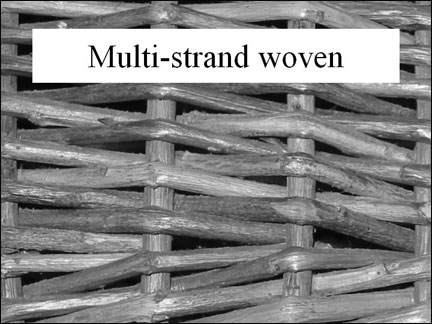
b) Multi-strand/multi-spiral: a separate strand starts behind
each rib and spirals steeply upward paralleling its neighbors.
Changing the rib count requires ending the weaving with a single
solid row and beginning again. This technique has limited potential
for use in bowl shaped baskets, and is best suited to fill large
straight-sided or cone shaped areas where the rib count is constant.
A cone shape can be achieved by using tapered weavers with the
smallest end down. As the weavers get fatter, they force the diameter
of the basket outward. This same concept can be used in many of
the woven techniques as an alternative to adding or subtracting
ribs.
2. Twined (twisted): two or more strands travel around the basket
(or back and forth on a tray shaped piece) twisting around each
other. Normally a half twist is used, which alternates the position
of the twiners each time one passes behind a rib, locking the
`stitchí in place (see illustration). Because it can grip
the ribs tightly, open work patterns can be created.
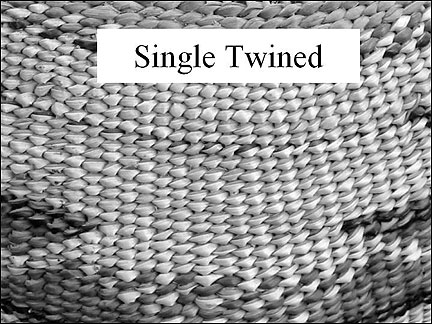
a) Single twined: two weavers alternate behind one rib at a time. Ribs can be added in at any time necessary to achieve the desired shape. Can be used to create open work patterns.
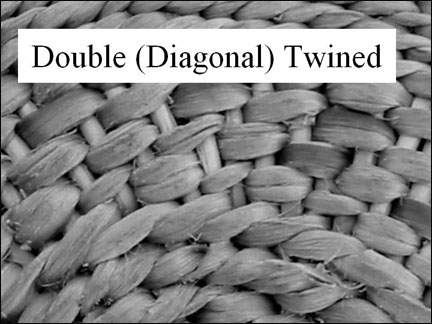
b) Double, or Diagonal Twined: two weavers alternate behind
two ribs at a time, with succeeding rows offset like brickwork.
To maintain the pattern, two ribs are added in on successive `stitchesí.
Patterning can also be achieved using a clockwise twist ñ
giving an up-to-the-right pattern, or counter-clockwise twist
to give a down-to-the-right pattern. Diagonal stripes are created
when the two weavers are of different colors.
c) Three (or more) Strand Twining: three or more weavers alternate
in a pattern such as over two, under one, giving a slightly raised
texture and steeper slant to the weaving.
d) Overlay Twining: colored strands are wrapped around the weavers
to show on the principle surface of the basket. Materials can
be used that are too weak to use on their own. This is a common
style used with single twining in the Pacific Northwest of North
America.
B. Plaited: typically done on the diagonal using flat strips that follow an over-under pattern with half the strips moving to the right and the other half to the left equally, so that there is no distinction of ribs and weavers, warp and weft. The Native People of the Southeastern United States used split river cane to make plaited baskets. Plaiting is also commonly used to weave mats, hats and bags in the Pacific Islands. A common feature of plaited projects is the formation of an edge by folding a strip at a 45-degree angle and sending it back in the opposite direction, sometimes forming a second layer of the basket (Tarahumara for example) or mat. Plaiting also refers to flat braided strips (very long and narrow mats?) used to make straw hats.
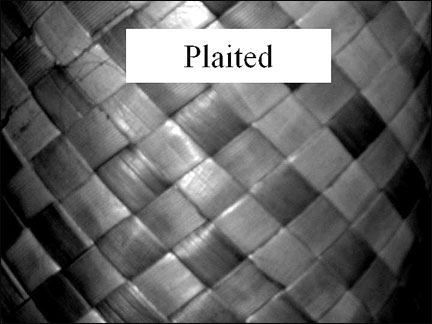
1) Simple Plaited: woven in `over one, under oneí pattern.
2) Pattern Plaited: woven in specific patterns such as `over one,
under twoí, which create various twill patterns, especially
when different colors of weavers are used.
II. Coiled: a cordlike core is stitched in a spiral to the row below, creating a round or oval pattern that grows along its edge. Think of a braided rag rug.
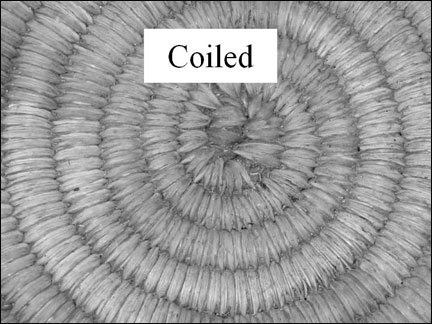
A. Single Rod Coiling: one rod (stick or vine) is sewn along
the edge, with the stitches passing between the previous rows.
1) Every stitch passes between the previous rows.
2) Lazy stitch ñ some stitches simply wrap around the rod,
with others binding the rod to the edge of the work.
B. Three Rod Coiling: three rods (one on top over the other two) are sewn to the top rod of the previous row. Stitches can be set between the previous rows stitches or through them. This is a stronger technique than single rod.
C. Bundle Coiling: multiple fibers (pine needles, spit leaves,
grass stems, etc.) are stitched down to the previous row.
1) Solid coiling ñ every stitch is complete, and next to
the one before.
2) Lazy Stitch ñ as in single rod above.
3) Split Stitch ñ stitches angle so that they are separated,
with core material showing (old fashion bee hives or skeps for
example), and often split the stitches in the previous row, creating
a pattern (common in pine needle work, and Papago baskets from
Arizona).
III. Other: this includes everything else.
A. Combinations: Using more than one type at a time, e.g. ñ coiling over ribs, or twining over a coil, rows of twining in a woven basket, etc.
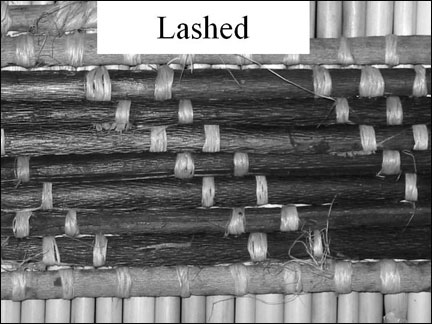
B. Lashed or tied baskets: using cordage or fibers to tie the
parts of the basket together. A raft is a large, stiff lashed
basket, a house frame for a thatched, domed house is an upside
down lashed basket.
1) Lashed over ribs: resembles a twined or woven basket.
2) Lashed over coils: radial lines of lashing ñ see the
article in BPT #17 by Alice Tulloch and Judith Polanich (page
43) ñ Uíkuyus Basketry.
C. Sewn baskets: flat material sewn together along the edge,
e.g. ñ bark berry basket.
D. Random: like a birdís nest or felt.
E. Anything else Iíve forgotten or never heard of.
Techniques world wild are closely aligned to the available
materials. The Natives of the southeastern United States used
river cane for many things, and used flat strips of split cane
to make plaited baskets. Hawaiians used Lahala leaves in a similar
manner. Plaiting works best with flat, ribbon-like materials.
In California, split roots and slender stems worked well for both
coiled and twined baskets, which could be worked tightly enough
to hold water. Stiffer materials work well in woven work. The
northern forests provided Birch Bark. Each group made the most
of what was at hand and developed specific ways of cultivating
and processing materials, starting the basket, adding in ribs
and weavers, finishing and decorating their baskets. An expert
can identify the cultural group that made a basket by analyzing
these factors - sometimes even identifying the weaver.
This article was first published in The
Bulletin of Primitive Technology (Fall 2002, #24)
E-mail your comments to "Norm Kidder " at atlatl1@aol.com
We hope the information on the PrimitiveWays website is both instructional and enjoyable. Understand that no warranty or guarantee is included. We expect adults to act responsibly and children to be supervised by a responsible adult. If you use the information on this site to create your own projects or if you try techniques described on PrimitiveWays, behave in accordance with applicable laws, and think about the sustainability of natural resources. Using tools or techniques described on PrimitiveWays can be dangerous with exposure to heavy, sharp or pointed objects, fire, stone tools and hazards present in outdoor settings. Without proper care and caution, or if done incorrectly, there is a risk of property damage, personal injury or even death. So, be advised: Anyone using any information provided on the PrimitiveWays website assumes responsibility for using proper care and caution to protect property, the life, health and safety of himself or herself and all others. He or she expressly assumes all risk of harm or damage to all persons or property proximately caused by the use of this information.
© PrimitiveWays 2013